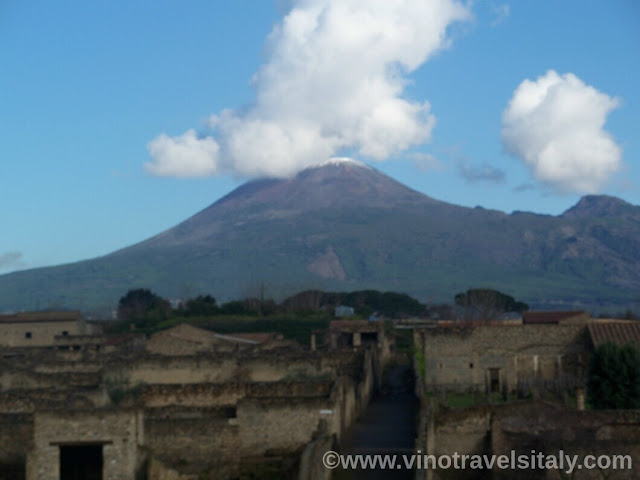Campania, a region in Southern Italy, has deep roots in ancient winemaking and viticultural practices influenced strongly by the Greeks, Etruscans and Romans. Campania served as a center of the Magna Grecia, “Great Greece”, which were colonies of the Greeks in southern Italy. They were very instrumental in the development of agriculture and viticulture for the fertile lands of the area.
Aristotle wrote of vineyards being planted in Campania since 5 B.C. One of the more important wines to note coming out of the Campania wine region are those known as Lacryma Christi. The name translates to “tears of Christ”, which hold many legends with one of the most common being that God shed tears when Lucifer stole a piece of heaven.
The wines of Lacryma Christi are a sub-designation under the Vesuvio DOC created in 1983, although these wines have been grown here for centuries. The Vesuvio DOC is made up of over 100 producers with vineyards located on the slopes of Mt. Vesuvius, an active volcano located right off the Bay of Naples. As you’re probably aware, Mt. Vesuvius is famous for the eruption of 79 A.D. when it destroyed the towns of Pompeii and Ercolano. According to the Vesurvio DOP Consorzio, "the area under vine is 391 hectares with over half (52%) of the vineyard area declared a Protected Designation of Origin (PDO) for the production of the Vesurvio DOC and Lacryma Christi DOC wines".
 |
| Copyright of Vesuvio DOP Consorzio |
 |
| My visit to Pompeii in 2007 with a view of Mt. Vesuvius |
For the Lacryma Christi Bianco wines the grape coda di volpe leads the charge. A grape exclusively found in Campania, coda di volpe translates to “white foxtail” that describes the shape of the grape cluster that develops. This grape can also be blended with verdeca, falanghina and greco.
In recent decades the producers have advanced winemaking practices and increased the overall quality of wines being developed in this region. Mastroberadino is one of the most famed producers of this region for producing high quality wines along with Feudi di San Gregorio and others.
- Camilla at Culinary Adventures with Camilla shares "Melanzanea Scarpone + Cantine Astroni Gragnano Penisola Sorrentina 2018"Wendy at A Day in the Life on the Farmposts "Polpetteand Terredora di Paolo Lacryma Christi del Vesuvio Rosso"David at Cooking Chat shares “Salmon with Pestoand Orzo with Wine from Campania"Pinny at Chinese Food and Wine Pairings adds "Campania’sDonnachiara Greco di Tufo Paired with Fish and Chips #ItalianFWT”Gwendolyn at Wine Predator shares "3Wines from Campania’s Feudi Di San Gregorio paired with pizza and wild boarragu”Cindy at Grape Experiences writes “Exclusiveto Campania: Coda di Volpe Bianco, the Tail of the Fox”Linda at My Full Wine Glass posts “ACoda di Volpe wine from Campania’s protector of native grapes (#ItalianFWT)”Terri at Our Good Life “ChickenPot Pie and A Beautiful Wine from Campania for a Spring Day”Katarina at Grapevine Adventures muses “Campania Makes You Dream Big About Amazing Wine”Nicole at Somm's Table dishes on "Donnachiara Taurasi and Lamb Spezzatino”Jeff at Food Wine Click! writes about "ViniAlois: Champions of Campania's Native Grapes"Rupal at Syrah Queen brings “NYC Somm Jordan SalcitoMaking A Splash With Campania Wines"Lauren at The Swirling Dervish adds “MastroberardinoGreco di Tufo: White Wine from Campania's Volcanic Arch"Lynn from Savor the Harvest shares "Italy- Organic Wine and Rare Grapes In Campania #ItalianFWT"Susannah at Avvinare presents “Taking Another Look At Falanghinafrom Campania"
I have always loved the Lacryma Christi Wines of Vesuvio. Thanks for the reminder that I need to track down a bottle! Cheers.
ReplyDeleteI am happy that you found the primary grape used for this wine. I enjoyed my bottle very much.
ReplyDeleteCan't say I've had one of these wines outside of an official tasting situation. Thanks for the inspiration to seek them out. Cheers Jennifer!
ReplyDeleteJennifer -
ReplyDeleteLoved seeing your photo of Vesuvius. I don't drink nearly as much of Lacryma Christi as I should. Fun to read your take on it and the history behind it. Susannah
Nice choice of wine for our Campania month. Hard to believe Vesuvio is still active, just read a prediction that the next eruption could be between 300 and 500 years from now. We're safe!
ReplyDeleteGood background on the wines of Lacryma Christi. I opened a Mastroberadino Bianco for this post and was delighted by its apricot aroma and creamy mouthfeel. Would love to try a Rosso next time.
ReplyDelete